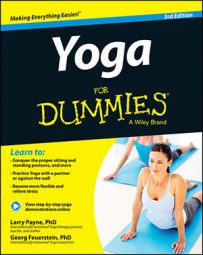The Sanskrit word uttana (pronounced oo-tah-nah) means “extended,” and this Yoga posture certainly fits that bill. The standing forward bend stretches the entire back of the body and decompresses the neck (makes space between the vertebrae). When a person stands in an upright posture, the cervical spine and the neck muscles work hard to balance the head.
Because most people generally don’t pay enough attention to this part of their anatomy, they tend to accumulate a lot of tension in their necks, which can lead to headaches. This posture frees the cervical spine and allows the neck muscles to relax. It also improves overall circulation and has a calming effect on the body and mind. The following steps walk you through the process.
![[Credit: Photograph by Adam Latham]](https://www.dummies.com/wp-content/uploads/431560.image0.jpg)
Be careful of all forward bends if you’re having a disc problem. If you’re unsure, check with your doctor or health professional.
Start in mountain posture and, as you inhale, raise your arms forward and then up overhead.
As you exhale, bend forward from your hips.
When you feel a pull in the back of your legs, soften your knees and hang your arms.
If your head isn’t close to your knees, bend your knees more.
If you have the flexibility, straighten your knees but keep them soft. Relax your head and neck downward.
As you inhale, roll up slowly, stacking the bones of your spine one at a time from bottom to top, and then raise your arms overhead.
Rolling is the safest way to come up. If you don’t have back problems, after a few weeks, you may want to try more advanced techniques.
Repeat Steps 1 through 4 three times, and then stay in the folded position (Step 3) for 6 to 8 breaths.
In the classic posture, the feet are together and the legs are straight. The forehead presses against the shins, and the palms are on the floor.

